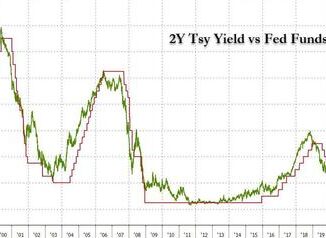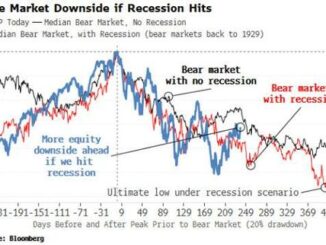
This will not go down well with the climate alarmists and ESG grifters…
No lesser mortal than Fed Governor Christopher Waller has dared to proclaim that climate change does not pose such “significantly unique or material” financial stability risks that the Federal Reserve should treat it separately in its supervision of the financial system.
His comments echo Chair Powell’s more conservative attitude towards The Fed’s responsibility for climate issues than its counterparts in Europe, who previously said that the U.S. central bank was not a climate policymaker and would not steer capital or investment away from the fossil fuel industry, for example.
So presumably this means The Fed does not believe the world will end within a decade in a devastating flood and fireball?
Climate change is real, but I do not believe it poses a serious risk to the safety and soundness of large banks or the financial stability of the United States. Risks are risks. There is no need for us to focus on one set of risks in a way that crowds out our focus on others. My job is to make sure that the financial system is resilient to a range of risks. And I believe risks posed by climate change are not sufficiently unique or material to merit special treatment relative to others. Nevertheless, I think it’s important to continue doing high-quality academic research regarding the role that climate plays in economic outcomes, such as the work presented at today’s conference.
In what follows, I want to be careful not to conflate my views on climate change itself with my views on how we should deal with financial risks associated with climate change. I believe the scientific community has rigorously established that our climate is changing. But my role is not to be a climate policymaker. Consistent with the Fed’s mandates, I must focus on financial risks, and the questions I’m exploring today are about whether the financial risks associated with climate change are different enough from other financial stability risks to merit special treatment. But before getting to those questions, I’d like to briefly explain how we think about financial stability at the Federal Reserve.
Financial stability is at the core of the Federal Reserve and our mission. The Federal Reserve was created in 1913, following the Banking Panic of 1907, with the goal of promoting financial stability and avoiding banking panics. Responsibilities have evolved over the years. In the aftermath of the 2007-09 financial crisis, Congress assigned the Fed additional responsibilities related to promoting financial stability, and the Board of Governors significantly increased the resources dedicated to that purpose. Events in recent years, including the pandemic, emerging geopolitical risks, and recent stress in the banking sector have only highlighted the important role central banks have in understanding and addressing financial stability risks. The Federal Reserve’s goal in financial stability is to help ensure that financial institutions and financial markets remain able to provide critical services to households and businesses so that they can continue to support a well-functioning economy through the business cycle.
Much of how we think about and monitor financial stability at the Federal Reserve is informed by our understanding of how shocks can propagate across financial markets and affect the economy. Economists have studied the role of debt in the macroeconomy dating all the way back to Irving Fisher in the 1930s, and in the past 40 years it has been well established that financial disruptions can reduce the efficiency of credit allocation and have real effects on the broader economy. When borrowers’ financial conditions deteriorate, lenders tend to charge higher rates on loans. That, in turn, can lead to less overall lending and negatively affect the broader economy. And in the wake of the 2007-09 financial crisis, we’ve learned more about the important roles credit growth and asset price growth play in “boom-bust” cycles.
Fundamentally, financial stress emerges when someone is owed something and doesn’t get paid back or becomes worried they won’t be paid back. If I take out a loan from you and can’t repay it, you take a loss. Similarly, if I take out a mortgage from a bank and I can’t repay it, the bank could take a loss. And if the bank hasn’t built sufficient ability to absorb those losses, it may not be able to pay its depositors back. These dynamics can have knock-on effects on asset prices. For example, when people default on their home mortgage loans, banks foreclose and seek to sell the homes, often at steep discounts. Those foreclosure sales can have contagion effects on nearby house prices. When a lot of households and businesses take such losses around the same time, it can have real effects on the economy as consumption and investment spending take a hit and overall trust in financial institutions wanes. The same process works when market participants fear they won’t be paid back or be able to sell their assets. Those fears themselves can drive instability.
The implication is that risks to financial stability have a couple of features. First, the risks must have relatively near-term effects, such that the risk manifesting could result in outstanding contracts being breached. Second, the risks must be material enough to create losses large enough to affect the real economy.
These insights about vulnerabilities across the financial system inform how we think about monitoring financial stability at the Federal Reserve. We identify risks and prioritize resources around those that are most threatening to the U.S. financial system. We distinguish between shocks, which are inherently difficult to predict, and vulnerabilities of the financial system, which can be monitored through the ebb and flow of the economic cycle. If you think about it, there is a huge set of shocks that could hit at any given time. Some of those shocks do hit, but most do not. Our approach promotes general resiliency, recognizing that we can’t predict, prioritize, and tailor specific policy around each and every shock that could occur.
Instead, we focus on monitoring broad groups of vulnerabilities, such as overvalued assets, liquidity risk in the financial system, and the amount of debt held by households and businesses, including banks. This approach implies that we are somewhat agnostic to the particular sources of shocks that may hit the economy at any point in time. Risks are risks, and from a policymaking perspective, the source of a particular shock isn’t as important as building a financial system that is resilient to the range of risks we face. For example, it is plausible that shocks could stem from things ranging from increasing dependence on computer systems and digital technologies to a shrinking labor force to geopolitical risk. Our focus on fundamental vulnerabilities like asset overvaluation, excessive leverage, and liquidity risk in part reflects our humility about our ability to identify the probabilities of each and every potential shock to our system in real time.
Let me provide a tangible example from our capital stress test for the largest banks. We use that stress test to ensure banks have sufficient capital to withstand the types of severe credit-driven recessions we’ve experienced in the United States since World War II. We use a design framework for the hypothetical scenarios that results in sharp declines in asset prices coupled with a steep rise in the unemployment rate, but we don’t detail the specific shocks that cause the recession because it isn’t necessary. What is important is that banks have enough capital to absorb losses associated with those highly adverse conditions. And the losses implied by a scenario like that are huge: last year’s scenario resulted in hypothetical losses of more than $600 billion for the largest banks. This resulted in a decline in their aggregate common equity capital ratio from 12.4 percent to 9.7 percent, which is still more than double the minimum requirement.
That brings us back to my original question: Are the financial risks stemming from climate change somehow different or more material such that we should give them special treatment? Or should our focus remain on monitoring and mitigating general financial system vulnerabilities, which can be affected by climate change over the long-term just like any number of other sources of risk? Before I answer, let me offer some definitions to make sure we’re all talking about the same things.
Climate-related financial risks are generally separated into two groups: physical risks and transition risks. Physical risks include the potential higher frequency and severity of acute events, such as fires, heatwaves, and hurricanes, as well as slower moving events like rising sea levels. Transition risks refer to those risks associated with an economy and society in transition to one that produces less greenhouse gases. These can owe to government policy changes, changes in consumer preferences, and technology transitions. The question is not whether these risks could result in losses for individuals or companies. The question is whether these risks are unique enough to merit special treatment in our financial stability framework.
Let’s start with physical risks. Unfortunately, like every year, it is possible we will experience forest fires, hurricanes, and other natural disasters in the coming months. These events, of course, are devastating to local communities. But they are not material enough to pose an outsized risk to the overall U.S. economy.
Broadly speaking, physical risks could affect the financial system through two related channels. First, physical risks can have a direct impact on property values. Hurricanes, fires, and rising sea levels can all drive down the values of properties. That in turn could put stress on financial institutions that lend against those properties, which could lead them to curb their lending, and suppress economic growth. The losses that individual property owners can realize might be devastating, but evidence I’ve seen so far suggests that these sorts of events don’t have much of an effect on bank performance. That may be in part attributable to banks and other investors effectively pricing physical risks from climate change into loan contracts. For example, recently researchers have found that heat stress–a climate physical risk that is likely to affect the economy–has been priced into bond spreads and stock returns since around 2013. In addition, while it is difficult to isolate the effects of weather events on the broader economy, there is evidence to suggest severe weather events like hurricanes do not likely have an outsized effect on growth rates in countries like the United States.
Over time, it is possible some of these physical risks could contribute to an exodus of people from certain cities or regions. For example, some worry that rising sea levels could significantly change coastal regions. While the cause may be different, the experience of broad property value declines is not a new one. We have had entire American cities that have experienced significant declines in population and property values over time. Take, for example, Detroit. In 1950, Detroit was the fifth largest city in the United States, but now it isn’t even in the top 20, after losing two-thirds of its population. I’m thrilled to see that Detroit has made a comeback in recent years, but the relocation of the automobile industry took a serious toll on the city and its people. Yet the decline in Detroit’s population, and commensurate decline in property values, did not pose a financial stability risk to the United States. What makes the potential future risk of a population decline in coastal cities different?
Second, and a more compelling concern, is the notion that property value declines could occur more-or-less instantaneously and on a large scale when, say, property insurers leave a region en masse. That sort of rapid decline in property values, which serve as collateral on loans, could certainly result in losses for banks and other financial intermediaries. But there is a growing body of literature that suggests economic agents are already adjusting behavior to account for risks associated with climate change. That should mitigate the risk of these potential “Minsky moments.” For the sake of argument though, suppose a great repricing does occur; would those losses be big enough to spill over into the broader financial system? Just as a point of comparison, let’s turn back to the stress tests I mentioned earlier. Each year the Federal Reserve stresses the largest banks against a hypothetical severe macroeconomic scenario. The stress tests don’t cover all risks, of course, but that scenario typically assumes broad real estate price declines of more than 25 percent across the United States. In last year’s stress test, the largest banks were able to absorb nearly $100 billion in losses on loans collateralized by real estate, in addition to another half a trillion dollars of losses on other positions.
What about transition risks? Transition risks are generally neither near-term nor likely to be material given their slow-moving nature and the ability of economic agents to price transition costs into contracts. There seems to be a consensus that orderly transitions will not pose a risk to financial stability. In that case, changes would be gradual and predictable. Households and businesses are generally well prepared to adjust to slow-moving and predicable changes. As are banks. For example, if banks know that certain industries will gradually become less profitable or assets pledged as collateral will become stranded, they will account for that in their loan pricing, loan duration, and risk assessments. And, because assets held by banks in the United States reprice in less than five years on average, there is ample time to adjust to all but the most abrupt of transitions.
But what if the transition is disorderly? One argument is that uncertainty associated with a disorderly transition will make it difficult for households and businesses to plan. It is certainly plausible that there could be swings in policy, and those swings could lead to changes in earnings expectations for companies, property values, and the value of commodities. But policy development is often disorderly and subject to the uncertainty of changing economic realities. In the United States, we have a long history of sweeping policy changes ranging from revisions to the tax code to things like changes in healthcare coverage and environmental policies. While these policy changes can certainly affect the composition of industries, the connection to broader financial stability is far less clear. And when policies are found to have large and damaging consequences, policymakers always have, and frequently make use of, the option to adjust course to limit those disruptions.
There are also concerns that technology development associated with climate change will be disorderly. Much technology development is disorderly. That is why innovators are often referred to as “disruptors.” So, what makes climate-related innovations more disruptive or less predictable than other innovations? Like the innovations of the automobile and the cell phone, I’d expect those stemming from the development of cleaner fuels and more efficient machines to be welfare-increasing on net.
So where does that leave us? I don’t see a need for special treatment for climate-related risks in our financial stability monitoring and policies. As policymakers, we must balance the broad set of risks we face, and we have a responsibility to prioritize using evidence and analysis. Based on what I’ve seen so far, I believe that placing an outsized focus on climate-related risks is not needed, and the Federal Reserve should focus on more near-term and material risks in keeping with our mandate.
And cue the outrage mob…



